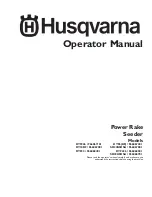
Ground Drive - Calibration
Page
38
02/07
Example 3
A 6 outlet meterbox is to be used to
plant oats at 65kg/ha. The meterbox has all
6 meterwheels fitted. The implement has a
12.25 metre planting width which will
require 31.4 calibration handle turns. (refer
page 56).
To determine the appropriate setting for
the adjustment assembly, refer to page 47.
The approximate setting is 5.2. Also noted,
on the top of page 47 is the need to remove
the cover plate above the meterwheels. To
do this, refer to page 112 in the meterbox
section.
After the plate has been removed and
some oats placed in the bin, the collection
tray is fitted to the meterbox and calibration
handle turned 31.4 turns.
Seed collected = 2.6kg/ha (2602 grams)
Actual sowing rate =2.6 x 20 = 52 kg/ha.
Therefore, increase setting to obtain the
correct rate. Retest after adjustment.
Example 4
An application rate of 4.5 kg/ha of
canola is desired on a planting width of
14.75 metres using a 4 outlet meter box
with all meter wheels in place. From page
56 we can determine the required handle
rotations (26 turns) and page 53 the
approximate variator setting (1.0) for 4
primary hoses with meterwheel reduction
cover plates fitted (refer page 110).
Seed collected = 0.237 kg (237 grams)
Actual sowing rate
= .237 kg x 20 = 4.74 kg/ha
Therefore reduce the variator setting
from 1.0 to 0.95 to obtain 4.5 kg/ha and
retest.
NOTE:
It is not recommended to run
below
0.75
setting
on
the
variator
adjustment assembly. Fit metershaft
reduction plates to the metershaft assembly
to reduce the metering capacity if required
(refer page 110).
The monitor alarm may also need to be
lowered when planting low rate crops.
Refer to the Operating Section (page 32)
for instructions on how to lower the preset
alarm value.
Method C:
To be used for low rate seeding where
a high degree of accuracy is required or
when seeding in difficult conditions eg. very
soft ground or with worn tyres.
Step 1. Check the wheel circumference to
determine
the
appropriate
calibration procedure. This will
require the operator to check the
distance travelled after a certain
number
of
rear
drive
wheel
rotations on the seeder. Once this
is obtained we can multiply the
figure by a known ratio to determine
the exact number of calibration
handle turns to do our standard
1/20
th
of
a
hectare
sample
(Method B).
When doing the wheel test it is
important that the bins are half full of
product and that the tyre pressure is correct
(refer specification pages). Testing should
be carried out on the ground being sown.
When a seeder is hitched to the
implement and in the paddock sitting on
cultivated ground you should:
a.
Mark the left-hand rear tyre (drive
wheel) with chalk or paint on the
sidewall at the base of the tyre
(vertical
line
through
wheel’s
centreline).
b.
Place a marker on the ground next to
the mark on the tyre.


































